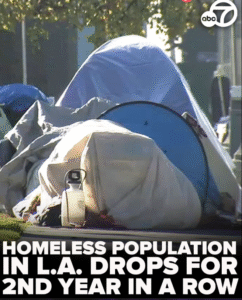For the second consecutive year, Los Angeles County has seen a drop in its homeless population, marking a hopeful shift in a crisis that has long plagued the region. New data released by the Los Angeles Homeless Services Authority (LAHSA) revealed a modest but meaningful decrease in both sheltered and unsheltered homelessness. Advocates and officials attribute the progress to a combination of expanded housing programs, targeted outreach, and increased coordination across agencies.
According to the report, the total homeless count across Los Angeles County dropped by approximately 2% compared to the previous year. While the decrease may seem small, it is being celebrated as a positive trend, particularly following years of consistent increases that saw homelessness climb to crisis levels. Notably, the City of Los Angeles itself experienced a similar decline.
Officials noted that the number of people experiencing chronic homelessness—those who have been homeless for an extended period and suffer from disabling conditions—also declined. This segment of the population is among the most difficult to house and support, so even a slight reduction in chronic homelessness is viewed as a critical win.
One of the key factors driving the decline has been the aggressive expansion of interim and permanent supportive housing. The city and county have increased investments in emergency shelters, transitional housing, and long-term units that provide not just a roof, but also wraparound services like mental health care and addiction treatment.
Programs like “Inside Safe,” championed by Los Angeles Mayor Karen Bass, have focused on moving people off the streets and into motels or temporary housing, with the aim of stabilizing individuals before transitioning them to permanent units. As of this year, Inside Safe has moved thousands of people out of encampments and into safer conditions. City leaders credit the program for much of the improvement in visible street homelessness.
“Our efforts are working, but we know the road ahead is long,” said Mayor Bass in a statement following the data release. “This is proof that when government acts with urgency and compassion, change is possible. But we must continue to scale up our response and ensure that everyone has access to housing and services.”
County Supervisor Hilda Solis echoed the sentiment, stating, “We are seeing the results of unprecedented collaboration. Now is not the time to be complacent—we must build on this momentum.”
While housing interventions are making a difference, officials caution that the homelessness crisis is far from over. The data shows that homelessness remains widespread and deeply entrenched, particularly among Black and Latino populations, who are disproportionately represented. Many individuals cycle in and out of housing due to high rents, low wages, and a lack of safety nets.
Rising housing costs continue to be a major driver of homelessness in the region. Although the overall number of homeless individuals has declined, tens of thousands still live on the streets, in vehicles, or in temporary shelters. Advocates warn that unless the region continues to address the underlying affordability crisis, gains could be reversed.
“There’s progress, but we’re still in a state of emergency,” said a spokesperson from the Coalition to End Homelessness. “It’s like bailing water out of a sinking boat—we need to stop the leak, and that means building more affordable housing and preventing evictions.”
Los Angeles has also benefited from increased state and federal funding, particularly through programs like Project Homekey, which converts hotels and motels into long-term housing for people exiting homelessness. Additionally, recent legislation has made it easier for local governments to bypass zoning restrictions to build homeless housing more quickly.
The report noted a few other key trends:
-
A slight increase in the number of homeless veterans receiving housing and services.
-
Improved data collection methods that allowed for more accurate counting of people in hard-to-reach areas.
-
An increase in the number of outreach workers and mental health professionals deployed across the county.
Still, there are significant challenges. Many service providers are overwhelmed, and housing navigation often takes months due to bottlenecks in available units. There are also gaps in care for those with severe mental illness or substance use disorders, some of whom cycle through hospitals, jails, and the streets without long-term stability.
Encampments remain a visible issue in many neighborhoods, leading to tensions between housed and unhoused residents. Some business owners and neighborhood groups continue to express frustration, calling for faster action and cleaner public spaces. At the same time, advocacy groups caution against enforcement-led approaches that criminalize homelessness without offering meaningful solutions.
“There’s no quick fix to this,” said a lead policy analyst from LAHSA. “But the data shows that targeted investment, sustained commitment, and compassion-driven policy can make a difference.”
Looking ahead, the city and county plan to ramp up housing production even further, with a goal of building thousands of new affordable units in the next five years. Officials are also focusing on prevention, seeking to stop homelessness before it starts by providing rental assistance, legal aid, and tenant protections.
The back-to-back declines are being treated as a sign that Los Angeles may have finally turned a corner in addressing homelessness. But leaders stress that continued progress will require vigilance, funding, and public support.
“This is the result of years of hard work,” Mayor Bass said. “We must continue to fight—not just for numbers, but for the dignity and future of every Angeleno.”


